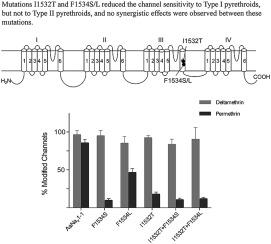Insect Biochemistry and Molecular Biology ( IF 3.2 ) Pub Date : 2020-05-22 , DOI: 10.1016/j.ibmb.2020.103411 Ru Yan 1 , Qiaoling Zhou 2 , Zhanyi Xu 2 , Guonian Zhu 2 , Ke Dong 3 , Boris S Zhorov 4 , Mengli Chen 1

|
Voltage-gated sodium channels are the major targets of several classes of insecticides, including pyrethroids. However, sensitivities of many insect pest species to pyrethroids have gradually decreased due to overuse in pest management programs. One major mechanism of pyrethroid resistance known as knockdown resistance (kdr) involves mutations in the sodium channel gene. Three new mutations in helix IIIS6 of sodium channel (I1532T and F1534S/L) are recently detected in several pyrethroid-resistant populations of Aedes albopictus. The roles of these mutations in pyrethroid resistance have not been functionally examined. We introduced mutations I1532T and F1534S/L alone or in combination into the pyrethroid-sensitive sodium channel AaNav1-1 from Aedes aegypti by site-directed mutagenesis and explored effects of these mutations on the channel gating and sensitivity to pyrethroids. No significant modifications in channel properties were detected, except for a slightly changed activation by F1534S and I1532T + F1534S. However, I1532T and F1534S/L substantially reduced the channel sensitivity to Type I pyrethroids, permethrin and bifenthrin, but not to two Type II pyrethroids, deltamethrin and cypermethrin. The double mutations did not increase the channel resistance to permethrin or bifenthrin. We have built a Nav1.4-based homology model of the AaNav1-1 channel and docked pyrethroids in the model to explain different sensitivities of the mutants to Type I and Type II pyrethroids. The results will assist in developing molecular markers for monitoring pest resistance to pyrethroids. They also provide new insight in the molecular basis of different action of Type I and Type II pyrethroids on sodium channels.
中文翻译:

白纹伊蚊的三个钠通道突变赋予对I型而不是II型拟除虫菊酯的抗性。
电压门控钠通道是包括拟除虫菊酯在内的几种杀虫剂的主要目标。但是,由于在害虫管理程序中使用过多,许多害虫对拟除虫菊酯的敏感性逐渐降低。拟除虫菊酯抗性的一种主要机制称为敲低抗性(kdr),涉及钠通道基因的突变。最近在几个对拟除虫菊酯有抗药性的白纹伊蚊种群中发现了钠通道螺旋IIIS6的三个新突变(I1532T和F1534S / L)。这些突变在拟除虫菊酯抗性中的作用尚未经过功能检查。我们引入的突变I1532T和单独或组合F1534S / L到拟除虫菊酯敏感钠通道AANA v从1-1埃及伊蚊通过定点诱变和探索这些突变对通道门控和对拟除虫菊酯敏感性的影响。除了F1534S和I1532T + F1534S的激活略有变化之外,未检测到通道属性的任何重大更改。但是,I1532T和F1534S / L大大降低了对I型拟除虫菊酯,氯菊酯和联苯菊酯的通道敏感性,但对两种II型拟除虫菊酯,溴氰菊酯和氯氰菊酯的通道敏感性却没有降低。双重突变并未增加对苄氯菊酯或联苯菊酯的通道抗性。我们已经建立了基于Na v 1.4的AaNa v同源模型模型中的1-1通道和对接拟除虫菊酯用于解释突变体对I型和II型拟除虫菊酯的不同敏感性。该结果将有助于开发分子标记物,以监测害虫对拟除虫菊酯的抗药性。他们还提供了有关I型和II型拟除虫菊酯在钠通道上不同作用的分子基础的新见解。











































 京公网安备 11010802027423号
京公网安备 11010802027423号